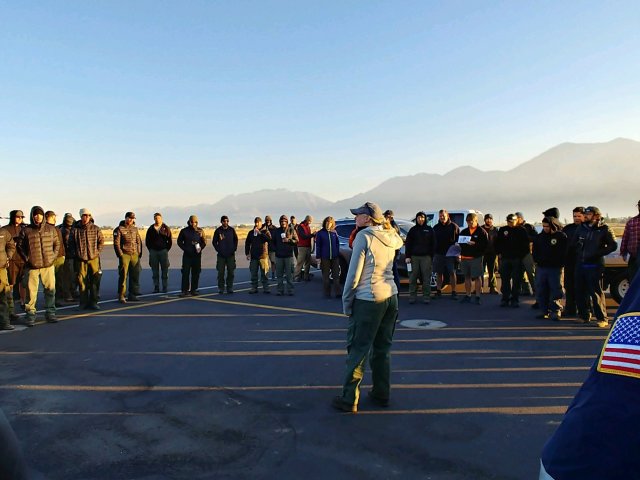Forecasting Smoke from Utah Wildfires to Protect Public Health
Published December 13, 2018
EPA researcher Gayle Hagler recently used her air quality expertise to provide information to the public about wildfires in the western United States. From late September through early October, Hagler served as an Air Resource Advisor (ARA) for the U.S. Forest Service’s Wildland Fire Air Quality Response Program. She was stationed with Utah’s Pole Creek and Bald Mountain fires, southeast of Salt Lake City. The fires, caused by lightning strikes, grew to cover approximately 120,000 acres of the Uinta-Wasatch-Cache National Forest. Her work schedule was intense.

“Mornings came early,” Hagler shared. “I was usually up around 4:15am, searching for a cup of coffee and working on a smoke forecast to deliver by 7:30am. The work day was typically about 15 hours and lodging was a tent I brought from home.”
One of the ARAs’ main tasks is to create a daily “Smoke Outlook,” a concise document communicating information to the public about the fire conditions, meteorology, and predicted fine particulate matter (PM2.5) levels in areas downwind of the wildfires. Embedded with the incident management team, the ARA has real-time information about the fire behavior and firefighting plans, which they can integrate into their forecast of anticipated smoke conditions.
The report also promotes fact sheets and real-time air quality information available on the EPA-managed AirNow website, and likewise, the AirNow website links to the Smoke Outlooks from their Fire page. In Utah, the daily Smoke Outlook was also shared each morning through social media, email distribution, community boards, and the InciWeb all-risk incident information management system. Air quality data from WFAQRP’s temporary air monitors is also incorporated into EPA’s AirNow website.
Hagler supported an Incident Management Team, along with public information officers, fire behavior analysts, and incident meteorologists, all collaborating to support incident response and address public health and safety concerns.
“Our mornings often included a helibase briefing with pilots assigned to the fire,” Hagler said. “For this incident, they were interested in the ARA providing the pilots information on expected smoke levels and visibility throughout the day.”

The Wildland Fire Air Quality Response Program (WFAQRP) was initiated by the U.S. Forest Service in 2011 to proactively address the growing concerns about the impacts of wildfire smoke on public health and safety. This program, which partners with other federal agencies including EPA, trains and deploys ARAs to offer technical assistance to major wildfire incidents throughout the United States at the request of incident commanders.
The program depends on four primary components: air quality monitoring, smoke concentration and dispersion modeling, coordination and cooperation with agency partners, and specially trained ARA personnel. Currently, there are around 90 ARAs in the country and nine of them are EPA-affiliated.
Moving forward, Hagler believes EPA has much to offer the WFAQRP, particularly by advancing monitoring capabilities for future ARAs, and providing resources that support smoke-ready communities. “I think there will be an ongoing challenge and opportunity to explain the diversity of air quality information sources available to the public,” Hagler said. “The WFAQRP is a young program that has more and more ARA deployments each year. There are many areas where EPA can contribute to this program’s continued growth and improvement.”
